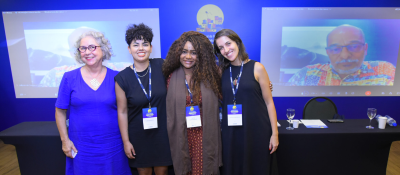RIP Subnormal Agglomerations Part 2 - Housing Rights and Favela Stigma in the Official Nomenclature
This is the second article in a series of three about how Brazil’s census bureau, IBGE, held an unprecedented week-long workshop to debate how to change the term “subnormal agglomeration” used for decades to describe the nation’s informal settlements, from the perspective of favelas and working-class communities.
By Julio Santos Filho • Translation by Nathan Bergrin[1][2].
The Right to Land and the City in Favelas and Brazilian Urban Communities[editar | editar código-fonte]
The central aim at the start of the second day was to encourage the construction of an alternative approach to the question of land ownership, one that builds off the condition of (in)security of tenure, and that recognizes the institution of tenure as necessary for guaranteeing the right to the city. The discussion covered conceptual, methodological, and operational possibilities and challenges of guaranteeing the permanence of residents in their areas.
Betânia Alfonsin, from the Rio Grande do Sul Superior School Foundation of the Public Ministry and the Brazilian Institute of Urban Law (IBDU), argues that it is paramount to highlight the coloniality imbued in the term subnormal agglomeration. According to her, it is necessary to assure and recognize that tenure be a legitimate method of accessing secure housing.
“Brazil has always had two forms of accessing land ownership since the colonial era: the regime of tenure, and the regime of property. In 1850, the Land Law determined who owns land in Brazil… Next to private property, we persist with a system of land access through tenure… This is how Brazilian law legitimized the hierarchy of the nation’s space. Private property became associated with being legal, formal, regular, and normal. And tenure was associated with being illegal, informal, irregular, subnormal… The coloniality of our legal gaze inferiorizes self-produced settlements, legitimizing racism and hatred for the poor, and limiting the exercise of citizenship for stigmatized residents… We need to value the access to land through tenure, a form of giving social function to land, and to value self-construction, self-management… the social construction of human habitat.” — Betânia Alfonsin
Carina Guedes, founder of Architecture in the Periphery and of the Advisory Institute for Women and Innovation (IAMÍ), communicates the importance of valuing these spaces that are “territories of potency, that construct the city from an alternative point of view.”
There was consensus that the diversity of perspectives come from innumerable distinct types of habitation, and that such diversity must be reflected in the new nomenclature. In the words of José Fernando Nunes Debli, of the Pernambuco Public Defenders’ Office and of the National Council of Public Defenders (CONDEGE): “language has a very large impact on the application of the law… it is paramount to use a vocabulary that recognizes the legitimacy of tenure in the occupation of space.”
Rafael Soares Gonçalves, professor at the Pontifical Catholic University of Rio de Janeiro (PUC-Rio) and author of several books on favelas, provides a brief history on how approaches to define what constitutes a favela have changed over time.
“In the 1950s, the demographic census included the term ‘favela,’ reinforcing that they are areas of irregular occupation on lands owned by others and emphasizing the legal dimension. In the 1980s, the census already included the term ‘urban agglomeration,’ and then ‘subnormal agglomeration.’ From the 1990s on, the ownership of land became a central question, and favelas became [defined as] spaces that did not have ownership titles… However, many favelas do have titles, and many spaces outside the favela do not have titles… The 2000 Census included other denominations such as ‘clandestine subdivisions,’ bringing further complexities… In the 2010s, the census brought a temporal dimension… [adding to the definition of favelas] territories that had obtained ownership less than ten years prior.” — Rafael Soares Gonçalves
In his presentation, he says it is evident to him that these legal perspectives were never able to adequately explain such urban phenomena in all their diversity. For this reason, more than conclusions, he offers points of reflection on the theme.
“In speaking about favelas today, I want to bring forth the idea of ‘boundary spaces’… First, we need to reverse our gaze. We tend to say: the favela has been regularized, so it’s no longer a favela. But many favelas were created by the State and many are registered and regularized, although the dynamics of favelas continue to exist… When does the ‘favela’ become ‘city’, and when does ‘city’ become ‘favela’? Second, how do we handle the homogenization of these spaces? We can’t treat them all the same way.” — Rafael Soares Gonçalves
Representations, Classifications, and Narratives about Favelas and Brazilian Urban Communities and IBGE’s Role[editar | editar código-fonte]
With the objective of debating what constitute stigmatizing narratives and where they originate, Letícia Giannella, researcher at IBGE, mediated a conversation regarding the causes and consequences of representations and classifications produced by the Institute. Furthermore, this discussion sought to determine the role of IBGE in overcoming these narratives while facing the challenge of portraying Brazilian reality, without conceiving of favela territories solely through what they lack.
“Thinking about the main objective of our event, to rethink the concept of subnormal agglomeration and overcome it, certain questions come to mind: where does the idea that these territories are defined by lack and absence come from? Where do the stigmas regarding the peoples and territories of the favela, understood as the Other within the city, come from?” — Letícia Giannella
Sônia Fleury, coordinator of the Marielle Franco Favelas Dictionary and researcher at the Center for Strategic Studies at Fiocruz, began by noting that the plural ‘favelas’ in the dictionary’s name is not by chance. It is precisely due to their inherent diversity that there is no precise definition of ‘favelas’ in the Marielle Franco Favelas Dictionary. However, Sônia makes an effort to outline general characteristics of favelas.
“The main characteristics [of the favelas] are that they are complex, multifaceted, and exist in a dynamic process, in continuous movement, both materially and symbolically… They verticalize themselves, at a material level, and resignify themselves, at a symbolic level… It is a mode of creation and expansion of the city according to the population’s own dynamics of self-organization, due to the absence of efficient public policy… Favelas are a form of resistance for the right to the city and cannot be understood as a counterpoint to the formal city… favelas are expansions of the city… There is a principle that permeates all favelas that I have seen: a powerful sense of belonging to the territory, manifested in specific cultures, languages, and local dynamics… They are a form of fragmented and hierarchized integration, where the population is placed in a clientelistic position with public authorities.” — Sônia Fleury
According to Fleury, “this is a historic moment in the conceptual dispute over what it means to be a favela resident.” For the researcher, there is a need for a movement that reconstructs the image of the favela, and what it means to be a favela resident based on these multiple principles. Next, Laís Borges, researcher at the Favelas Museum, in São Paulo, returned to the idea that the concept of social cleansing permeates all social categorization in Brazil, particularly regarding predominantly Black areas.
“Classification, representation, and narrative equal power. This toolkit shapes imaginaries, which in turn lead to practical actions. Who created the term ‘subnormal agglomeration’? Were they Black? Were they people from favelas? What is the relationship between the State and the favela throughout Brazilian history?… It is a term that exemplifies and reproduces the coloniality of knowledge itself, the perpetuation of colonial domination in political and cultural form. It is the logic of ‘the civilized versus the savage,’ ‘the city versus the favela.’” — Laís Borges
Ju do Coroadinho, director of the PerifaConnection network and resident of Coroadinho, the fourth largest favela in Brazil, in São Luís do Maranhão, begins by saluting the only four Black people in the audience during the discussion. She expresses her discomfort with the fact that, even in a space like this seminar, the majority still consists of white individuals from Brazil’s southeast.
“Honestly, I feel very uncomfortable with the number of white people talking about favelas, talking about us. They have never lived there, they haven’t lived our experiences… It also makes me very uncomfortable that in discussions about favelas, we almost always only speak about Rio and São Paulo.” — Ju do Coroadinho
She also challenges the common sentiment that favelas are illegal and that their residents are invaders. “‘Irregular occupation’ makes me uncomfortable as well, as I am the fifth generation living in Coroadinho. How am I irregular if my great-great-grandmother, who I never even met, already lived here?” To her, these discussions have taken this long to happen because favela residents have not yet been humanized. There is a need for accessible research, carried out by Black people, from the favelas and peripheries if we want “to understand the favela beyond the white and southeastern view.” Jailson de Souza e Silva, cofounder of CEASM and of the Favelas Observatory, in Complexo da Maré, retired Fluminense Federal University (UFF) professor and current Brazilian National Development Bank (BNDES) employee, began by affirming his own status as a native of the Mangueirinha Favela in Brás de Pina, in Rio de Janeiro’s North Zone. According to him, two essential concepts in transforming our idea of subnormal agglomerations are the Paradigm of Absence and the Paradigm of Potency. To him, the features most characteristic of favelas are collectivity and potency.
“Collective coexistence in the favelas is an element as important as material issues… that is why the favela reinvents the city, as it elevates the concept of the ‘polis’ over that of the ‘urbes.’ It brings self-care, self-organization, and collective coexistence into public space.” — Jailson de Souza e Silva
Closing the conversation, Jailson reiterates Ju do Coroadinho’s key point: that representation is necessary in order to decolonize research.
“For this job, our point of departure has to be peripheral epistemology, with peripheral actors, both locally and globally… We need to recognize non-white ancestral knowledge in Brazilian education and in the pursuit of future paths… IBGE has to understand this and truly hire Black and peripheral employees, because this transformation will not take place in theory alone… It has to be in practice, inscribed on the body. We need Black and peripheral subjects and bodies occupying these spaces of research and building public policies.” — Jailson de Souza e Silva
About the author[editar | editar código-fonte]
Julio Santos Filho has a Bachelor’s in International Relations (UFF) and a Master’s in Sociology (IESP-UERJ). A Black man from Ilha do Governador, he has worked as editor of RioOnWatch since 2020. In 2021, he edited the series “Rooting Anti-Racism in the Favelas”, a silver medalist in The Anthem Awards.
View more[editar | editar código-fonte]
Favelas, pandemias e cidadanias (lives)
Vidas negras e faveladas importam (debate)
Juventudes em favelas (debate)
- ↑ November 9, 2023. Via RioOnWatch
- ↑ Clique aqui para acessar a matéria em Português.

